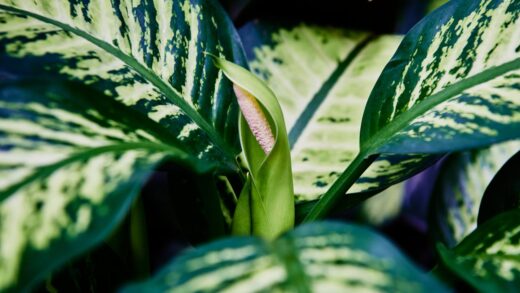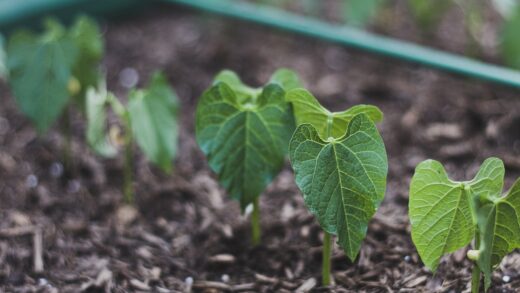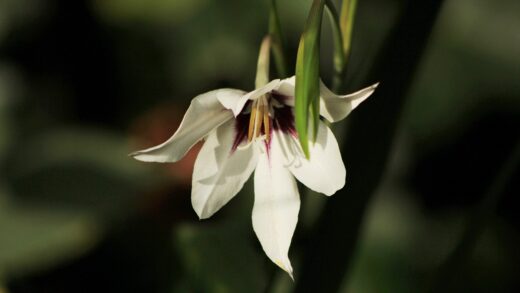The Asiatic dayflower is typically treated as an annual in regions that experience freezing winter temperatures, as its succulent stems and foliage are not equipped to survive a hard frost. Its natural life strategy in these climates is to complete its cycle of growth, flowering, and seed production within a single season, dying back with the onset of winter. The continuation of the species is ensured by the numerous seeds it produces, which can remain dormant in the soil and germinate the following spring when conditions become favorable again. Therefore, for many gardeners, the process of overwintering is less about preserving the individual plant and more about managing its succession from one year to the next.
This reliance on self-seeding is the most common and lowest-effort method for ensuring the plant’s return each year. By allowing some of the last flowers of the season to mature and form seed pods, the plant will naturally disperse its seeds throughout the immediate area. These seeds possess a natural hardiness that allows them to endure the cold winter months, protected within the soil. Come spring, as the soil warms, a new generation of seedlings will emerge, often in a dense and vigorous display, ready to repeat the cycle.
For gardeners who prefer more control over the plant’s placement or who wish to share it with others, collecting and saving the seeds is an excellent alternative. In late summer or early autumn, as the seed pods begin to turn brown and dry, they can be harvested from the plant. The tiny black seeds can then be separated from the chaff and stored in a cool, dry place, such as in a paper envelope in a refrigerator, until it is time to sow them the following spring. This method prevents the plant from spreading to unwanted areas and allows for intentional planting in desired locations.
While preserving the actual plant through the winter is not the standard practice, it is theoretically possible in certain situations, particularly for plants grown in containers. If a gardener is particularly attached to a specific specimen or wishes to get a head start on the next season, a potted Asiatic dayflower could be brought indoors to be overwintered as a houseplant. This requires providing it with the right indoor conditions, which can be challenging, but it offers a way to keep the same genetic plant alive from one year to the next.
Understanding its annual life cycle
The Asiatic dayflower’s classification as a tender annual in temperate climates is a direct result of its evolutionary adaptation to its native environment. The plant has developed a life strategy that prioritizes rapid growth and prolific reproduction within a limited, frost-free growing season. From the moment a seed germinates in the spring, the plant is in a race against time. It quickly develops its creeping stems and lush foliage, investing energy in creating a large photosynthetic area to fuel its primary objective: producing flowers and, subsequently, seeds.
More articles on this topic
The flowering period of the plant is a key part of this annual cycle. The distinctive blue flowers, though individually short-lived and often lasting for only a single day, are produced in succession over a long period throughout the summer. This extended blooming window maximizes the chances of successful pollination and ensures a continuous production of seeds. Each flower that is pollinated develops into a small seed pod, contributing to the bank of seeds that will ensure the next generation.
As the days shorten and temperatures cool in the autumn, the plant receives environmental cues to shift its energy allocation. Vegetative growth slows, and the focus turns entirely to maturing the last of its seeds. The foliage may begin to look tired or decline in quality, which is a natural part of its senescence. The plant has fulfilled its biological purpose, and once the first hard frost arrives, the top growth is killed, bringing its life cycle to a definitive end.
This annual strategy is what makes the plant both a charming garden addition and a potentially aggressive weed. Its ability to produce a large number of viable seeds, combined with their ability to lie dormant in the soil, gives it a powerful mechanism for persistence and spread. For the gardener, understanding this life cycle is crucial for management. It means that controlling the plant is largely a matter of controlling its seed production and dispersal, a task that must be undertaken before the plant completes its seasonal journey.
Overwintering via self-seeding
Relying on self-seeding is the most natural and hands-off method for overwintering the Asiatic dayflower. This approach leverages the plant’s innate reproductive strategy and requires minimal intervention from the gardener. The key to success with this method is to simply allow the plant to complete its full life cycle undisturbed in the late summer and autumn. Resist the urge to deadhead the last flush of flowers, as these are the ones that will produce the seeds necessary for the following year’s display.
More articles on this topic
As the season progresses, small seed pods will form where the flowers once were. It is important to let these pods mature fully on the plant. They will gradually dry out and turn brown, at which point they will split open to release their small, dark seeds onto the soil below. This natural dispersal mechanism ensures that the seeds are distributed around the parent plant, ready to germinate in the spring. The dead foliage of the parent plant can be left in place over the winter to provide a natural mulch that helps protect the seeds.
In the spring, as the soil warms, the overwintered seeds will begin to germinate. Often, a large number of seedlings will emerge, creating a dense carpet of new growth. At this stage, the gardener can choose to intervene by thinning out the seedlings to a desired spacing, typically around thirty centimeters apart. This thinning prevents overcrowding, which ensures that the remaining plants have adequate resources and air circulation to grow strong and healthy. The thinned seedlings can be composted or even carefully transplanted to other areas of the garden.
One consideration with the self-seeding method is the potential for the plant to spread beyond its intended boundaries. The seeds can be moved by water, wind, or wildlife, and seedlings may appear in unexpected places. For this reason, this method is best suited for more informal or naturalistic garden settings where some unpredictability is welcome. In more formal garden designs, collecting the seed for controlled sowing might be a more appropriate management strategy.
Collecting and storing seeds
For gardeners who prefer more control over the placement and population of the Asiatic dayflower, collecting and storing its seeds is the ideal overwintering method. This process is simple and ensures a reliable supply of seeds for the next growing season. The process should begin in late summer or early autumn, as the plant’s flowering begins to wane and the first seed pods start to mature. A mature seed pod will feel dry and papery to the touch and will typically have changed color from green to a light brown or tan.
To harvest the seeds, one can either pluck the individual mature pods from the plant or cut entire stems that have a good number of ripe pods. It is best to do this on a dry day to minimize the risk of mold. Once collected, the pods should be placed in a paper bag or on a tray in a well-ventilated area, away from direct sunlight, to allow them to dry completely for another week or two. This final drying stage is crucial for ensuring the long-term viability of the seeds and preventing them from rotting in storage.
After the pods are thoroughly dry, the seeds can be extracted. This is easily done by crushing the brittle pods between your fingers over a bowl or sheet of paper. The small, dark, and wrinkled seeds will be released along with a a certain amount of dried plant matter, known as chaff. To separate the seeds from the chaff, you can gently blow across the mixture; the lighter chaff will blow away, leaving the heavier seeds behind. This process is called winnowing.
Proper storage is the final and most critical step. The cleaned, dry seeds should be placed in a small paper envelope or a sealed glass jar. It is important to label the container clearly with the plant name and the date of collection. The seeds should then be stored in a cool, dark, and dry location. A refrigerator is an ideal place, as the cold temperatures help to maintain the seeds’ viability for a longer period and can also provide the cold stratification that may improve germination rates in the spring.
Overwintering in containers
While not the typical approach, it is possible to overwinter an entire Asiatic dayflower plant if it is grown in a container and brought indoors before the first frost. This method is best reserved for a particularly prized specimen, as it requires providing the right indoor environment throughout the winter months. The primary challenge is to give the plant enough light to survive, as it will not go into a true dormancy like many houseplants. A south-facing window is ideal, but even this may not be sufficient, and supplemental lighting with a grow light may be necessary.
Before bringing the plant indoors, it is essential to inspect it thoroughly for any pests, such as aphids or spider mites. It is much easier to treat these issues outside than to deal with an infestation inside the home. Trimming the plant back by about a third can make it more manageable indoors and can also help to remove any unseen pest eggs. This pruning can also encourage a new flush of more compact growth that is better suited to the lower light conditions of the home.
Once inside, the plant’s care routine will need to be adjusted significantly. The frequency of watering should be reduced, as the plant’s growth will slow down considerably in the lower light and cooler temperatures of a typical home. Allow the top few centimeters of soil to dry out between waterings, and ensure the pot has excellent drainage to prevent root rot. Fertilization should be stopped completely during the winter months, as the plant is not in a state of active growth.
As spring approaches and the days begin to lengthen, you may notice an increase in the plant’s growth rate. This is a sign that it is ready to prepare for its return to the outdoors. Begin to increase watering slightly, and you can resume fertilizing with a diluted, balanced liquid fertilizer. When the danger of frost has passed, the plant must be hardened off by gradually reintroducing it to outdoor conditions over a week or two before it can be left outside permanently for the new season.


















